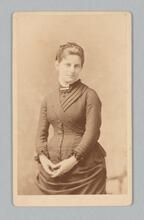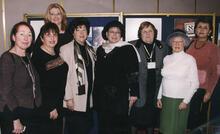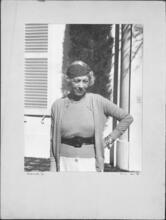Argentina: Philanthropic Organizations
In the early 20th century, large numbers of immigrant and second-generation Jewish Argentinians were struggling to earn a living. Three Jewish women’s philanthropic organizations emerged to support orphans and poor children in the community. The Society of Israelite Beneficent Women was responsible for the Jewish Girls’ Orphanage that opened in 1919. The women raised money through various means including raffles and solicited donations. The Yiddish-speaking Women’s Aid Association formed the Jewish Infants’ Home to help new mothers; they also ran a Kindergarten. The third group, The Women’s Commission, helped run the Jewish Boys’ Orphanage at the request of the men operated it. All three groups declined in the 1960s due to dwindling numbers of European Jewish refugees and the establishment of the state of Israel.
Argentine Jewish women’s philanthropic activities focused on performing the duties that other women (and poor men) were unable to perform. Among those, taking care of orphaned, abandoned, or needy children ranked high in importance. As these services were, at the time, provided by groups closely linked to the Catholic Church (or by the Church itself), this meant that Jewish children, if taken in by these societies, would grow up in a Catholic environment. Although the growth of Jewish communal institutions to provide these services to Jews was slow, by the 1930s three major groups of Jewish women were engaged in providing housing, religious instruction, and secular education for the orphans and poor children in their community. They also cared for refugee Jewish orphans during the two World Wars.
The first of the three groups, eventually known as the Sociedad de Damas Israelitas de Beneficencia (The Society of Israelite Beneficent Women), operated the Asilo Argentino de Huérfanas Israelitas (Young Women’s and Girls’ Orphanage of Argentina). The group began operations in 1908 and continued well into the 1950s. The second group, the Idischer Frauenhilfsverein (the Yiddish-speaking Women’s Aid Association), founded the Hogar Infantil Israelita as a day-care center and kindergarten for poor Jewish families. This group opened its home in 1931 as a way to help the community during the trying times of the Depression and operated the facilities well into the 1980s. The third group, known as the Comisión de Damas del Asilo Israelita Argentino (Women’s Commission of the Boys’ Jewish Orphanage) helped the men responsible for operating both an old-age home and a boys’ orphanage. This group, invited in 1921 by male philanthropists to help with fundraising, always operated with male supervision. The old-age home still exists, but the remaining boy orphans were sent to Israel in the 1980s.
Jewish organizations also came into being to aid poor Jewish women, as this type of support was also in the hands of Catholic women’s groups. In 1908, La Sociedad de Socorros de Damas Israelitas (the Aid Society of Israelite Women), an association within the Congregación Israelita Argentina (the group representing the oldest synagogue in Buenos Aires), was set up to help Jewish childbearing women and newborn children. Initially they limited their program to providing medical help, clothing, and food. In 1912, similar goals were adopted by another group, the Sociedad Israelita Femenina de Beneficencia (Israelite Female Beneficence Society), which lent small amounts of money to the poor and helped parturient women. It is possible, however, that the two groups were in fact one and the same.
The Society of Israelite Beneficent Women and the Girls’ Orphanage of Argentina
The first Jewish orphanage for boys and girls opened in 1918 as an adjunct to a nursing home that had been founded in 1915. In 1919 the Jewish girls’ orphanage opened and became the special responsibility of the Sociedad de Socorros de Damas Israelitas, which in 1927 was renamed the Sociedad de Damas Israelitas de Beneficencia. Argentine president Hipólito Yrigoyen (1852–1932) sent his personal representative to the opening ceremony on December 23, 1919. The intendent (mayor) of Buenos Aires later attended the celebration of the home’s first anniversary, and in March 1927, Argentine president Marcelo T. de Alvear (1868–1942) attended the inauguration of the new building constructed specifically for the orphanage on Arevalo Street. This was the first time an Argentine president personally attended an official function of the Jewish community.
The women raised money for the orphanage by organizing raffles, holding dances and kermesses (fashionable fairs where money was raised through raffles, races, etc.), requesting donations from the Jewish communities of the interior, and receiving special donations from the wealthier members of the congregation. A frequent contributor in the early years was the pioneer cinematographer Max Glücksmann, who also often held special benefit performances in his cinema, the Grand Splendid. His wife Rebecca became fourth president of the Sociedad in 1914, replacing Francisca R. de Krämer, whose husband helped select the site for the first orphanage. Rebecca R. de Glücksmann remained president until 1954, providing unwavering assistance to the home.
For the Jewish women, charity work offered several attractions. First of all, their good deeds acknowledged and reaffirmed their conception of Jewish solidarity in Buenos Aires. Secondly, they often organized programs together with their husbands, and their presence as married couples further reinforced their status within the community. Finally, they created a social space within the Jewish community that paralleled that of the Catholic Sociedad de Beneficencia de la Capital, whose name they adapted in 1927, and the Patronato de la Infancia, a charity organized by the city of Buenos Aires in 1890 and operated by men, with a group of equally elite women supporting them. These non-Jewish groups initiated annual collections in neighborhoods, and organized special occasions that served as fundraisers. Jewish women who imitated these groups legitimated their presence in some of the most elite social spaces in the city, particularly the Plaza Hotel and the Alvear Palace Hotel. The fact that these women had no problems holding activities at elegant hotels indicated that Buenos Aires high society accepted the Jewish women’s group at a time when antisemitism was increasingly visible.
The Yiddish-speaking Women’s Aid Association and the Jewish Infants’ Home
The history of another group of Jewish philanthropic women in Argentina indicates that the experience of the Sociedad de Damas Israelitas de Beneficencia was not unique. Although the second group began its efforts to aid children more than a decade later, it, too, became part of the community support offered to poor Jewish children. In 1931, in the midst of the worldwide depression, Yiddish-speaking women who called themselves German banded together to found the Hogar Infantil Israelita (Jewish Infants’ Home) that helped mothers of newborns and poor women. The Home was designed as a temporary place to house young children whose parents were ill or had to work, or one of whom was in hospital or deceased.
The founders, Rosa G. de Gierson, Ana S. de Garensky, Tary B. de Svartz, Esther de Fischer (the first president), Sofía de Milleritsky, Paulina Goldfarb, and Eva Priluk, planned to admit the children on a case-by-case basis. The kindergarten admitted children between the ages of four to six, who were bused to school each day. Within one year the home provided day-care facilities for seventy children under the age of six, mostly at its establishment in the Flores neighborhood.
The records of the Hogar Infantil initially documented all the cases they encountered. Often the petitioners had a letter from some member of the community. The women paid for circumcisions for boys, and generally took in children of hospitalized parents. They drew the line at unweaned babies until they opened their own infant section in 1934, but they provided health information to immigrant women by visiting them and speaking to them in Yiddish. They also published pamphlets in Yiddish. The women accepted Jewish children from the Argentine interior to justify the donations they solicited there, and they even donated monthly contributions to the local police home for children.
Since the children in their care had parents, most stayed at the institution or attended the day-care facilities as needed. Thus, when these Damas were approached by individuals seeking a child to adopt, they were quick to point out that they did not deal with such issues. Indeed, no Jewish institution that cared for children sent them into foster care or adoption.
Like the Sociedad de Damas Israelitas de Beneficencia, the Idischer Frauenhilfsverein raised money through dances at elegant hotels, but more often they held events on the grounds of the Hogar. By 1938 the missions of the women who operated the Hogar Infantil Israelita seemed to be very similar to those of the Asilo de Huérfanas. However, when they were approached regarding possible unification, the Frauenhilfsverein rejected this possibility. Instead, in 1940, they formalized their ideas and proposed statutes for the Institution, describing themselves as an organization of Israelite women who operated a children’s home designed to help indigent parents of preschool children, planned to create similar institutions throughout the capital city, and operated a ward for children under age two. By this time the home had moved to a new, larger location, and defined its character as a kindergarten with more than ninety children, most of them children of working-class people. It also opened its doors to Sephardi children, although the majority of children were of Ashkenazi origin.
The institution, which cared for one hundred to one hundred thirty children each day, had two buses that transported the children from the center to their homes. At that point they owned no buildings of their own, but instead relied on renting from others. A fundraising campaign, which continued into the 1940s, finally enabled them to purchase a building. By 1946 the organization, swamped with requests to help children, began to contemplate opening another institution.
To support their activities, the women organized collections similar to those of many Buenos Aires child welfare charities. An annual campaign just before the Jewish New Year raised money to pay for gifts of food; synagogue solicitations, bridge tournaments, dances, and an annual dinner brought additional income. Equally important were individual contributions from donors, who were always mentioned in extensive lists published in the organization’s annual reports, together with many pages of paid advertisements by members of the Jewish community—a tactic also adopted by the Damas Israelitas de Beneficencia.
Between December 1, 1930, and 1967, more than 4,048 children attended the day schools or lived in the dormitories of the Hogar Infantil. While the great majority were identified as Argentines because they were born in Buenos Aires, the next most frequent nationality was Polish. Other nationalities included Cuban, American, Uruguayan, Brazilian, Greek, Lithuanian, Palestinian, Chilean, German, and Austrian. The last two groups were most numerous in the late 1930s. Many of the Argentine children had Syrian parents, indicating the Hogar’s commitment to the Sephardi community. By the 1950s many of the parents were second-generation Argentines—a sign that many in the Jewish community had not been able to prosper after their arrival in Buenos Aires.
The Women’s Commission of the Jewish Boys’ Orphanage
The third group of Jewish female philanthropists, the Comisión de Damas del Asilo Israelita Argentino, was created at the request of the men who operated both the old age home and the boys’ orphanage. By the 1930s they were credited by the men with having improved the quality of food consumed by the boys. They organized public collections for the Semana del Huérfano (Orphan Boys’ Week), as well as fundraising balls and parties like those of the women operating the other institutions. Unlike their compatriots, however, these women did not have a say in the administration of the orphanage. In its 1946 annual report, the women’s mission was defined as one of “collaboration with the members of the [male] Board of Directors” in raising money.
Together the men and women who operated the boys’ orphanage managed to overcome chronic financial problems, as well as a space shortage that resulted in the construction of a new old age home and orphanage in the province of Buenos Aires. Aided by a donation from José Iturrat, a non-Jewish philanthropist who, in 1943, donated his ranch and all of the buildings to the organization, the new construction was completed in 1946.
As can be seen above, many Sephardim utilized the institutions for children that these Jewish women’s organizations created and supported. Sephardic congregations, for example, led fundraising events on their behalf among their members, and even brought the orphan children to participate in community festivals. Philanthropy for Sephardim exclusively was not, at first, in the hands of women, although they came to be exclusively in charge of it as time went on. (See Argentina: Sephardic Women)
These three groups of philanthropic women operated at a time when large numbers of immigrant Jews, as well as a large second-generation community of native-born Jews, were struggling to maintain their religious identity in a Catholic country and earn a living to support their families. The networks of Jewish philanthropic groups, both in the capital and in the interior provinces, supported a wide range of charitable institutions to help keep families together. The ultimate decline in the 1960s of groups like the Jewish orphanages resulted from a combination of Argentina’s receiving fewer European Jewish refugees after World War II than anticipated, and the establishment of the State of Israel. In Argentina, strong Zionist communities preferred to send orphans to Israel rather than maintaining them in local institutions.
Brodsky, Adriana. Sephardi, Jewish, Argentine: Community and National Identity, 1880-1960.
Bloomington, IN: Indiana University Press, 2016.
Coni, Emilio R. Higiene social; Asistencia y previsión social. Buenos Aires caritativo y previsor. Buenos Aires: 1918.
Deutsch, Sandra McGee. Crossing Borders, Claiming a Nation: A History of Argentine Jewish
Women, 1880-1955. Durham: Duke University Press, 2010.
Guy, Donna J. Sex and Danger in Buenos Aires: Prostitution, Family and Nation in Argentina. Lincoln, Nebraska: 1991.
Guy, Donna. "Women's Organizations and Jewish Orphanages in Buenos Aires, 1918-1955."
Jewish History 18, no. 1 (2004): 75-93.
Guy, Donna. Women Build the Welfare State: Performing Charity and Creating Rights in
Argentina, 1880-1955. Durham: Duke University Press, 2009.
Hogar Infantil Israelita, Memoria y Balance General, 1931–1960.
Lerner, Gloria Rut, “El Asilo de Huérfanas Israelitas,” unpublished Licenciature Thesis, Universidad Nacional de Luján.
Sociedad de Socorros de Damas Israelitas. Reseña sobre la marcha de la Sociedad de Socorros de Damas Israelitas. Buenos Aires: 1908–1927.







